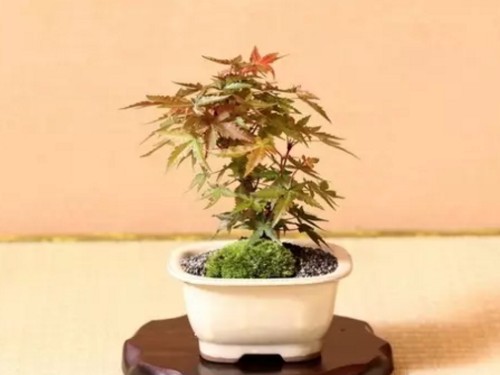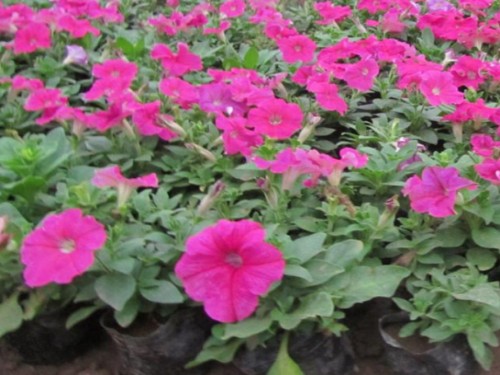Maintenance methods of Red Maple Bonsai
The production of red maple potted plants is not without careful care, because only careful care can make the red maple grow luxuriantly, the leaves will be red and beautiful, and the ornamental value will be higher. Bonsai can only be enjoyed by careful care. Compared with other plants, bonsai has a more edifying feeling. Let's learn about the maintenance methods of red maple bonsai:

1. General culture soil can be used for planting and put in a semi-shady place after watering. Often spray water on the branches. Light can be increased at the beginning of leaf development. Apply a light (nitrogen) fertilizer and water after all the leaves are spread. Put it in the half-shade where the sun is even for normal management.
2. Pay attention to ventilation in summer and autumn. Potted plants should be moved to a semi-shaded place around noon and pay attention to ventilation. When exposed to the scorching sun, the leaves should be scorched, curled and fallen. At the same time, pay attention to watering to prevent the soil from being too dry.
3. If you want to manually control the observation of leaves, it can be carried out once between spring and summer and between summer and autumn. Too much work will hurt the tree. All the leaves can be picked in June and September, and bright red new leaves can grow after 10 days. Pay attention to two points: one is to prune after picking leaves, and the other is to apply fertilizer a week before picking leaves. Artificial control of new leaves, fertilizer and water should be strengthened, which is the key to success.
4. If the leaves are scorched in the hot sun, all the charred leaves can be removed in August and placed in a cool semi-shaded place, and the compound solution of nitrogen, phosphorus and potassium can be applied lightly, about twice a week. In this way, bright red new leaves can grow in autumn.
5. when the leaves fall in winter and enter the dormancy period, nitrogen, phosphorus and potassium base fertilizer can be applied thinly and pruned, so that the branches and leaves in the early spring of the following year will be more red. If you encounter extremely cold special weather, bonsai should be placed in a warm place away from the wind and the sun or in a sunny place indoors to avoid freezing.
6. The main pests of red maple are: red wax shell beetle, blow cotton shell beetle and heart borer. Prevention of scale insects: wash with a toothbrush in small amounts, and spray with 1000 times of imidophos emulsion in severe cases. Prevention of heart borer: use a syringe to inject 2000 times of omethoate into the trunk pest section.
The maintenance of beautiful and atmospheric maple bonsai needs to pay attention to the following five aspects:
1. Venue
Maple trees like a shady and cool environment and avoid strong direct sunlight, so bonsai should be preserved under shade or other trees. Scorched leaves often occur if placed in strong light or on a balcony.
Due to poor indoor ventilation, maple bonsai should not be placed indoors for more than a week, otherwise it will be harmful to growth.
In winter in the north, maple bonsai should be moved into the low-temperature room, in the south, as long as the pot is buried in the leeward soil, it can survive the winter safely.
2. Watering
Maple leaves are large and water evaporates quickly. In the growing season, water should be often watered. When the weather is hot, water should often be sprinkled to the ground to keep the microclimate moist. The winter maple enters the dormant period, should water less, as long as the basin soil is wet, it can not be watered.
3. Fertilization
Before sprouting and spreading leaves of maple trees in spring, the rotten and thin organic liquid fertilizer should be applied once, but not in rainy days. From August to September, the rotten and thin liquid fertilizer should be applied once. Do not apply fertilizer during winter dormancy.
4. Plastic surgery
Maple trees have strong germination and often grow new buds on the trunk. Buds and over-dense branches that are not needed in modeling should be cut off in time, which can not only save nutrition, but also facilitate ventilation and light transmission. The best viewing period for maple trees is when the new leaves are just unfolded. If all the leaves are removed at the end of summer and a dilute liquid fertilizer is applied, new leaves can grow in about 20 days, which adds another best viewing period.
5. Prevention of diseases and insect pests
Maple trees mainly have powdery mildew, thorns, aphids and other diseases and insect pests, when problems should be timely prevention and control.
Time: 2019-06-01 Click:
- Prev

Breeding methods and matters needing attention of Petunia
Petunia is a long sunshine plant, which requires sufficient sunshine during the growing period. under normal light conditions, it takes about 100 days from sowing to flowering. Double spherical, very rich in color, such as white, red, purple, blue, yellow and mosaic, edge, etc., very beautiful. Florescence from April to frost fall
- Next

The culture method of purple delicate flower
Many people are not familiar with the name of purple flower, but the mention of leek may inspire memories of what purple flower is like: flat and wide leaves, tall and slender stems, one or more purple flowers blooming at the top of the flower path.
Related
- Fuxing push coffee new agricultural production and marketing class: lack of small-scale processing plants
- Jujube rice field leisure farm deep ploughing Yilan for five years to create a space for organic food and play
- Nongyu Farm-A trial of organic papaya for brave women with advanced technology
- Four points for attention in the prevention and control of diseases and insect pests of edible fungi
- How to add nutrient solution to Edible Fungi
- Is there any good way to control edible fungus mites?
- Open Inoculation Technology of Edible Fungi
- Is there any clever way to use fertilizer for edible fungus in winter?
- What agents are used to kill the pathogens of edible fungi in the mushroom shed?
- Rapid drying of Edible Fungi

